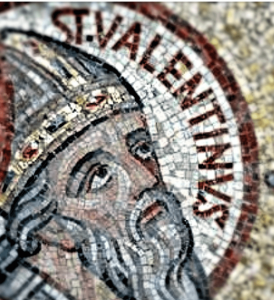RECENT POSTS
Categories
History of Valentine’s Day
As we all know, love’s complicated, and, fittingly, so is the history of Valentine’s Day. February 14th is all about romance– you show your love in boxes of chocolate, bouquets of roses, decadent dinners, and cheesy, heart-shaped cards. You may have grown up crafting valentines for your classmates and parents in school, or decorating sweet treats with pink and red frosting with your family at home. This Valentine’s Day you could be planning a romantic, candlelit proposal, while others may choose to cuddle up with their best friends to watch their favorite rom-com with some pizza and a glass of wine.
No matter how you choose to celebrate, Valentine’s Day is about sharing your love in big or little ways. But when you look into the history of how this fun, romantic holiday came to be, its dark, twisted past truly comes to light. From Ancient Rome to Victorian England, Valentine’s Day’s history and meaning, which is anything but fun and romantic, sheds light on how we got the traditions we have today.

The Legend of St. Valentine
It all started with St. Valentine, but, funnily enough, we’re not exactly sure who that is. It’s hard to pinpoint exactly one St. Valentine, as the Catholic church has recognized at least three martyred saints named Valentine or Valentinus; furthermore, two of these men were executed on February 14th by Roman emperor Claudius II in the third century.
Some legends state that Valentine was a priest from third century Rome. During this time, Roman Emperor Claudius II decreed that single Roman men made better soldiers than men with wives and families, leading him to outlaw marriage for any young men. It is said that Valentine recognized this injustice against young lovers, and decided to perform marriages for young men and women in secret. When Claudius II recognized Valentine’s defiance, he was beheaded in retaliation.
In other versions of the legend, Valentine was possibly a bishop killed for helping Christians escape harsh Roman prisons where they were being tortured. In another version of the story, Valentine received his name after imprisonment by actually sending the first “valentine” greeting in a letter he sent himself. Valentine fell in love with a young girl– some say she was a girl he tutored, while others say she was possibly his jailor’s daughter that would pay him visits in jail. Before his execution, it is said that Valentine wrote his young lover a letter signed “From your Valentine,” which is why we still use the expression today.
These anecdotes, while romantic, remain only legends, as little historical information is known about the martyrs named St. Valentine by the Roman Catholic Church. His story, no matter which you subscribe to, shows that Valentine was a historic, heroic, and romantic figure of the Roman ages. Due to his appealing reputation, Valentine would become one of the most popular saints in England and France by the Middle Ages.
Lupercalia to Valentine’s Day: Pagan Festivals and the Pope
While some believe the origin of Valentine’s Day can be found in the legends of St. Valentine, others think the holiday may have found its start through the efforts of the Christian church to Christianize the pagan celebration of Lupercalia.
Founded in the Roman empire, Lupercalia was a fertility festival dedicated to Faunus, the Roman god of agriculture, and Romulus and Remus, the founders of Rome. Lupercalia was kicked off with the Luperci, an order of Roman priests, gathering at a sacred cave where the infants Romulus and Remus were believed to be cared for by a she-wolf, or a lupa. The Luperci would sacrifice a goat for fertility and a dog for purification. Following this, the priests would strip the goat’s hide into pieces and dip them into the sacrificial blood. Then, they would take the bloody sheets into the street to gently slap both the women and crop fields with the hide.
It is, possibly, surprising to note that the Roman women, and crops, welcomed these gentle slaps of bloody goat hide. This is because the touch of the hides on a woman’s skin was thought to make them more fertile in the coming year.
Following this ritual, all the young women in the city would place their names in a giant urn. Then, the city’s male bachelors would each choose a name from the urn. The bachelor and the woman chosen would become paired for the next year, and these matches would often end in marriage.
Eventually, in the late fifth century, Pope Gelasius I outlawed the celebration of Lupercalia. There is not an exact record of the reasoning why; however, some sources believe that the Pope chose to replace this pagan holiday with the celebration of St. Valentine’s Day on February 14th, which is the official start of the declared holiday.

Valentine’s Day: The Shift to Love and Romance
After outlawing Lupercalia and establishing St. Valentine’s Day, it did not take long for the day to become associated with love and romance. As mentioned previously, Valentine would become one of the most popular saints in England and France by the Middle Ages. This is because it was commonly believed in France and England that February 14th was the beginning of the birds’ mating season; this added to the idea that Valentine’s day, associated with the popular saint, should be a day for romance.
In 1375, Geoffrey Chaucer– the English Poet who famously wrote The Canterbury Tales– produced the first record of St. Valentine’s Day as a day of romance in his poem “Parliament of Foules.” In this poem, he states, “For this was sent on Syent Valentyne’s day / Whan every foul cometh ther to choose his mate.” This line also plays into another theory that Chaucer could have invented the idea of Valentine’s Day that we have today, which he based on the previous theories discussed about the martyr Valentine.
The Symbols of Valentine's Day
As Valentine’s Day developed, it became a holiday all about romances, gifting, and proving your love. In turn, many symbols of the famous holiday have developed over time, persisting through generations and places.
After 1400, written valentines began to appear in circulation. The oldest known valentine was a poem written in 1415 by Charles, Duke of Orleans, to his wife during his imprisonment in the Tower of London after his capture at the Battle of Agincourt. This valentine is, impressively, still in existence today, sitting in the manuscript collections at the British Library in London, England.
A common symbol that is often portrayed on valentine’s cards and decorations themselves is Cupid, which seems suspicious considering that the chubby cherub has nothing to do with the history of Valentine’s Day. The Roman God Cupid has roots in Greek Mythology as the Green God of love, Eros. Eros played with people and God’s emotions by shooting them with golden arrows to make them fall in love. During the Hellenistic period, Cupid became the mischievous, chubby child he is known as today.
When it comes to flowers, it is known that they have stood as symbols for love, fertility, romance, and marriage. The history of exchanging flowers for Valentine’s Day with your loved ones comes from the tradition of sending bouquets as non-verbal messages. In the 18th century, Charles II of Sweden introduced the idea that each flower had a specific meaning attached to it, making it possible to pass messages with only flowers. Today, people send flowers on special occasions– like Valentine’s Day– to express sentiments of love and happiness.
Valentine's Day: As We Know It Today
Today, Valentine’s day is celebrated in the United States, Mexico, the United Kingdom, France, and Australia. By the middle of the 18th century, the holiday had developed into what we see today. It became common for lovers and friends to acknowledge their relationships through exchanging small gifts, handwritten notes, and flowers. And, by 1900, printed Valentine’s Day cards replaced handwritten notes through improved printing technology. This technological development, along with cheaper postage rates, gave people an easy way to express their emotions in a commercialized, indirectly loving way.
In the United States specifically, Esther A. Howland started to sell the first mass-produced valentines in America in the 1840s. Known as the “Mother of the Valentine,” Howland created beautiful cards with lace, ribbon, scraps of paper, and pictures. According to the Greeting Card Association, Valentine’s day is the second largest card-selling holiday of the year with about 145 millions Valentine’s Cards bought and sent per year.
Frequently Asked Questions
Valentine's Day is believed to have replaced the pagan festival of Lupercalia, which celebrated fertility and love. Pope Gelasius I outlawed Lupercalia in the late fifth century, and the date was repurposed to commemorate St. Valentine. Over time, it evolved into a day for expressing love and romance.
Valentine's Day cards gained popularity in the 18th century. Esther A. Howland, known as the "Mother of the Valentine," played a significant role in America by creating the first mass-produced valentines in the 1840s. These cards featured lace, ribbons, and romantic imagery.
Common symbols include Cupid, hearts, roses, and doves. These symbols have come to represent love, affection, and romantic feelings, and they are often featured on Valentine's Day cards and decorations.
Valentine's Day is celebrated in various countries, including the United States, Mexico, the United Kingdom, France, and Australia. While the core theme of expressing love remains the same, customs and traditions may vary from one country to another.
Traditional gifts include chocolates, roses, romantic dinners, and handwritten love notes. Couples often exchange gifts as a way to express their affection and appreciation for each other.
Ready to work together? Contact us today for a free consultation.
HERE'S WHAT TO DO NEXT
If you or a loved one have been injured and think you might have a case, call us now for a free consultation.


